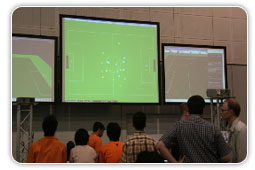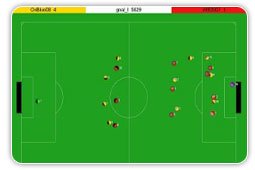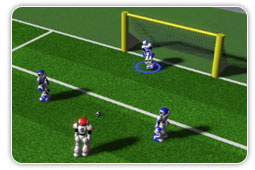|
|
RoboCupSoccer : Simulation League : General
| |
|
Without the necessity to maintain any robot hardware, the RoboCup Simulation League's focus comprises artificial intelligence and team strategy.
|
 |
| |
2D Simulation League
In the 2D Simulation League, two teams of eleven autonomous software programs (called agents) each play soccer in a two-dimensional virtual soccer stadium represented by a central server, called SoccerServer. This server knows everything about the game, i.e. the current position of all players and the ball, the physics and so on. The game further relies on the communication between the server and each agent. On the one hand each player receives relative and noisy input of his virtual sensors (visual, acoustic and physical) and may on the other hand perform some basic commands (like dashing, turning or kicking) in order to influence its environment.
|

|
The big challenge in the Simulation League is to conclude from all possible world states (derived from the sensor input by calculating a sight on the world as absolute and noise-free as possible) to the best possible action to execute. As a game is divided into 6000 cycles this task has to be accomplished in time slot of 100 ms (the length of each cycle). Further information and the SoccerServer software can be accessed via http://sserver.wiki.sourceforge.net |
3D Simulation League
The 3D simulation competition increases the realism of the simulated environment used in other simulation leagues by adding an extra dimension and more complex physics. At its beginning, the only available robot model was a spherical agent. In 2006, a simple model of the Fujitsu HOAP-2 robot was made available, being the first time that humanoid models were used in the simulation league. This shifted the aim of the 3D simulation competition from the design of strategic behaviors of in playing soccer towards the low level control of humanoid robots and the creation of basic behaviors like walking, kicking, turning and standing up, among others.
|

|
In 2008, the introduction of a Nao robot model to the simulation gave another perspective to the league. The real Nao robot from Aldebaran robotics has been the official robot for the Standard Platform League since 2008, and using the same model for the simulation competitions represents a great opportunity for researchers wanting to test their algorithms and ideas before trying them into the real robots. The interest in the 3D simulation competition is growing fast and research is slowly getting back to the design and implementation of multi agent higher level behaviors based on solid low level behavior architectures for realistic humanoid robot teams.
For more information, please check the league's official wiki:
http://wiki.robocup.org/wiki/Soccer_Simulation_League |
|
|